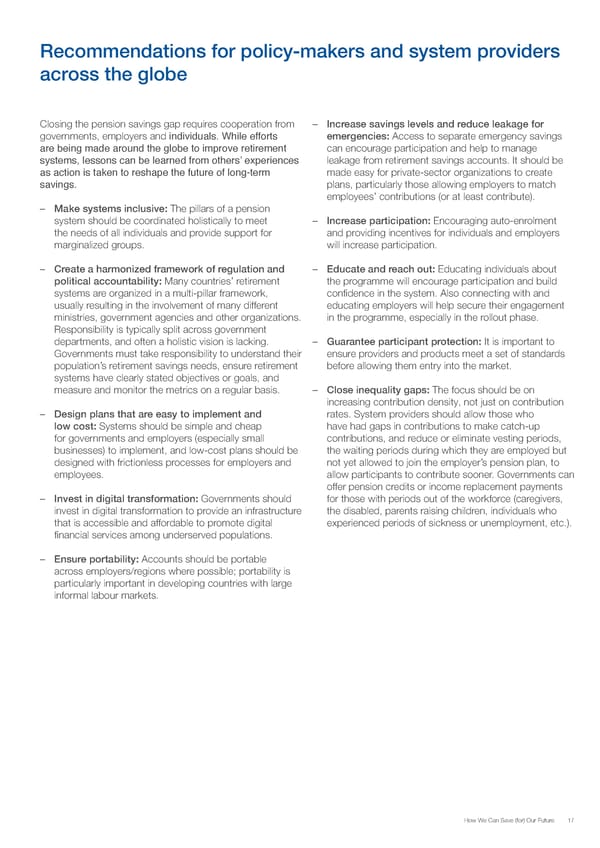Recommendations for policy-makers and system providers across the globe Closing the pension savings gap requires cooperation from – Increase savings levels and reduce leakage for governments, employers and individuals. While efforts emergencies: Access to separate emergency savings are being made around the globe to improve retirement can encourage participation and help to manage systems, lessons can be learned from others’ experiences leakage from retirement savings accounts. It should be as action is taken to reshape the future of long-term made easy for private-sector organizations to create savings. plans, particularly those allowing employers to match employees’ contributions (or at least contribute). – Make systems inclusive: The pillars of a pension system should be coordinated holistically to meet – Increase participation: Encouraging auto-enrolment the needs of all individuals and provide support for and providing incentives for individuals and employers marginalized groups. will increase participation. – Create a harmonized framework of regulation and – Educate and reach out: Educating individuals about political accountability: Many countries’ retirement the programme will encourage participation and build systems are organized in a multi-pillar framework, confidence in the system. Also connecting with and usually resulting in the involvement of many different educating employers will help secure their engagement ministries, government agencies and other organizations. in the programme, especially in the rollout phase. Responsibility is typically split across government departments, and often a holistic vision is lacking. – Guarantee participant protection: It is important to Governments must take responsibility to understand their ensure providers and products meet a set of standards population’s retirement savings needs, ensure retirement before allowing them entry into the market. systems have clearly stated objectives or goals, and measure and monitor the metrics on a regular basis. – Close inequality gaps: The focus should be on increasing contribution density, not just on contribution – Design plans that are easy to implement and rates. System providers should allow those who low cost: Systems should be simple and cheap have had gaps in contributions to make catch-up for governments and employers (especially small contributions, and reduce or eliminate vesting periods, businesses) to implement, and low-cost plans should be the waiting periods during which they are employed but designed with frictionless processes for employers and not yet allowed to join the employer’s pension plan, to employees. allow participants to contribute sooner. Governments can offer pension credits or income replacement payments – Invest in digital transformation: Governments should for those with periods out of the workforce (caregivers, invest in digital transformation to provide an infrastructure the disabled, parents raising children, individuals who that is accessible and affordable to promote digital experienced periods of sickness or unemployment, etc.). financial services among underserved populations. – Ensure portability: Accounts should be portable across employers/regions where possible; portability is particularly important in developing countries with large informal labour markets. How We Can Save (for) Our Future 17
 How can we save for our future Page 16 Page 18
How can we save for our future Page 16 Page 18